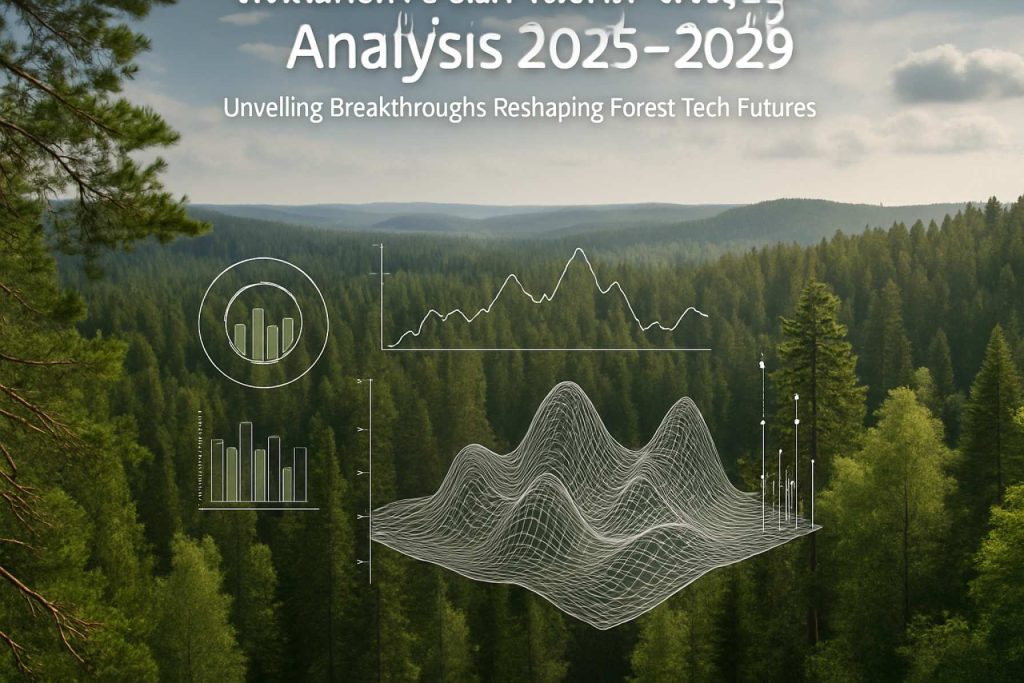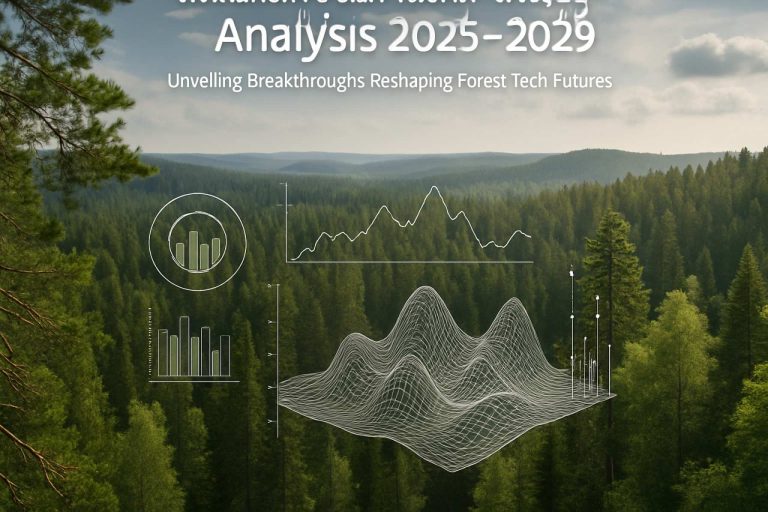
Table of Contents
- Executive Summary: Market Highlights & Key Takeaways
- Wavefront Aberration Technology: Fundamentals and Advancements
- Current Market Landscape (2025): Key Players and Emerging Entrants
- Adoption Drivers: Sustainability, Automation, and Ecosystem Monitoring
- Application Deep Dive: Precision Forestry, Growth Modelling, and Disease Detection
- Competitive Analysis: Leading Companies and Strategic Partnerships
- Market Forecasts 2025–2029: Growth Projections and Regional Trends
- Regulatory Environment and Industry Standards (e.g., ieee.org, ifa.org.uk)
- Technology Roadmap: Innovations and R&D Initiatives
- Future Outlook: Opportunities, Challenges, and Strategic Recommendations
- Sources & References
Executive Summary: Market Highlights & Key Takeaways
Wavefront Aberration Forestry Analysis is emerging as a transformative technology in precision forestry, leveraging optical metrology techniques traditionally used in astronomy and ophthalmology to monitor and improve forest health and productivity. In 2025, the integration of advanced wavefront sensors and adaptive optics into aerial and terrestrial forestry platforms is accelerating, driven by the need for higher-resolution, non-destructive forest assessment tools.
- Adoption and Applications: Forestry organizations and environmental agencies are adopting wavefront aberration analysis to address challenges in tree health diagnostics, biomass estimation, and canopy structure mapping. This technology offers significant improvements in spatial resolution and data fidelity compared to conventional LiDAR and multispectral imaging, enabling early detection of disease, pest infestation, and structural anomalies in forest stands.
- Key Industry Players: Companies such as Thorlabs Inc. and Edmund Optics are actively supplying adaptive optics and wavefront sensor components tailored for forestry instrumentation. Meanwhile, forestry equipment manufacturers like John Deere are exploring integration of these sensors into their autonomous ground and aerial vehicles for enhanced forest data acquisition.
- Technological Advancements: Recent advances in miniaturized Shack-Hartmann and curvature sensors, as well as real-time wavefront correction algorithms, are enabling deployment on lightweight UAVs and handheld devices. This year, Hexagon AB expanded its geospatial solutions portfolio to include prototype wavefront-enabled forestry scanners, supporting rapid in-field analysis and cloud-based data processing.
- Market Drivers: The main drivers include stricter regulatory requirements for sustainable forestry, the economic imperative for yield optimization, and escalating risks from climate-induced forest stressors. Funding from governmental bodies and international organizations is catalyzing pilot projects, especially in North America, Scandinavia, and Asia-Pacific forestry markets.
- Outlook (2025–2028): The market for wavefront aberration forestry analysis is expected to see robust growth, with ongoing investments in R&D aimed at reducing hardware costs and enhancing analytics platforms. Partnerships between optics manufacturers, drone companies, and forestry agencies are anticipated to yield commercial-grade, scalable solutions, positioning this segment as a key enabler of next-generation forest management and conservation strategies.
Wavefront Aberration Technology: Fundamentals and Advancements
Wavefront aberration technology, originally rooted in optical engineering and astronomy, has seen significant adaptation for environmental and forestry applications in recent years. In forestry analysis, wavefront aberration systems offer advanced capabilities for assessing canopy structure, tree health, and landscape-level forest metrics by measuring and correcting optical distortions in remote sensing data. As of 2025, the field is experiencing rapid integration of these technologies with airborne and terrestrial LiDAR, hyperspectral imaging, and drone-based platforms.
One of the fundamental advancements is the deployment of adaptive optics systems—originally developed for telescopic observations—to correct atmospheric-induced aberrations during aerial forestry surveys. Organizations like Leica Geosystems and RIEGL have incorporated wavefront correction modules into their airborne LiDAR and multi-sensor platforms. These modules enhance data fidelity, allowing for more precise estimation of forest canopy height, leaf area index, and biomass calculations, critical for carbon accounting and biodiversity monitoring.
Recent developments also include the miniaturization of wavefront sensors, such as Shack-Hartmann arrays, which are now being integrated into UAV payloads. Companies like DJI are exploring partnerships to embed such sensors in their enterprise drone systems, facilitating high-resolution, real-time assessment of forest health over large areas with reduced data distortion.
On the software side, advancements in machine learning are being leveraged to process wavefront-corrected datasets. Esri and Hexagon AB are actively developing geospatial analytics tools that can utilize corrected imagery and point clouds to classify tree species, detect disease outbreaks, and monitor forest regeneration with unprecedented accuracy.
Looking forward into the next few years, the focus will likely shift toward integrating wavefront aberration correction with multi-modal data fusion—combining LiDAR, hyperspectral, and thermal data for holistic forest ecosystem analysis. National and international organizations, including the Food and Agriculture Organization of the United Nations (FAO), are expressing interest in these technologies for global forest monitoring programs, emphasizing the importance of accurate, scalable, and cost-effective solutions.
As the impacts of climate change intensify and the demand for precise forest resource data grows, wavefront aberration technology is poised to become a standard component of next-generation forestry analysis platforms, driving both scientific discovery and practical resource management.
Current Market Landscape (2025): Key Players and Emerging Entrants
The wavefront aberration forestry analysis sector is evolving rapidly in 2025, driven by a confluence of advancements in optical sensing, remote imaging, and data analytics. As forests face mounting pressures from climate change, pests, and land use shifts, demand for high-resolution, distortion-corrected imaging has surged. This enables more accurate biomass estimation, health monitoring, and species identification.
Key players in this space traditionally hail from sectors specializing in advanced optics and environmental sensing. Leica Geosystems, a subsidiary of Hexagon AB, continues to lead with its suite of LiDAR and multi-spectral imaging platforms, which now integrate wavefront correction to enhance canopy penetration and ground truth accuracy. Hexagon has further expanded its reach by integrating AI-driven wavefront analysis modules into its environmental monitoring solutions.
Another notable player is Trimble, which has incorporated wavefront aberration correction into its forestry solutions, enabling improved detection of structural anomalies in dense forest canopies. These enhancements are particularly crucial for sustainable forest management and for supporting carbon capture initiatives. RIEGL—renowned for its high-precision laser scanning systems—has also launched new forestry-specific products in 2024-2025, leveraging wavefront analysis to achieve sub-centimeter accuracy in volumetric and health assessments.
Emerging entrants in 2025 include startups leveraging photonics and computational optics. Companies like SPECIM are deploying hyperspectral imagers with real-time aberration correction, offering forest managers unprecedented granularity in species discrimination and stress detection. Meanwhile, Teledyne Imaging is integrating wavefront sensing modules with drone platforms, lowering the barrier to entry for smaller operators and research institutes.
Collaborations are also shaping the market. For example, European Space Agency (ESA) is facilitating partnerships between sensor manufacturers and forestry agencies to pilot satellite-based wavefront aberration analysis, aiming to scale the technology for pan-European forest health monitoring.
As 2025 progresses, outlook for the next few years centers on the miniaturization of wavefront correction modules, increased cloud-based analytics, and democratization of access. The competitive landscape is expected to intensify, with both established players and agile newcomers driving innovation in precision forestry analytics.
Adoption Drivers: Sustainability, Automation, and Ecosystem Monitoring
The adoption of wavefront aberration analysis in forestry is increasingly driven by the need for sustainable resource management, automation in ecosystem monitoring, and the precision demanded by modern environmental stewardship. As climate change, biodiversity loss, and regulatory pressures intensify in 2025, forestry stakeholders are seeking advanced technologies to optimize forest health assessments and operational efficiencies. Wavefront aberration analysis—originally developed in optical sciences—now finds application in forestry through advanced imaging systems, remote sensing, and lidar-based platforms.
Sustainability goals are a primary motivator. Governments and certification bodies worldwide are pushing for transparent reporting on forest conditions, carbon sequestration, and habitat integrity. Wavefront aberration correction in imaging systems leads to higher fidelity data, enabling more accurate tree health analysis, disease detection, and biomass estimations. This, in turn, supports compliance with frameworks such as the UN’s REDD+ program and various national forest inventories (Food and Agriculture Organization of the United Nations).
Automation is another key driver. Forestry operations increasingly deploy drones and autonomous vehicles equipped with multispectral and hyperspectral cameras, many of which use wavefront correction to compensate for atmospheric and hardware-induced distortions. This enables continuous, large-scale monitoring of forest ecosystems with minimal human intervention, reducing labor costs and improving safety. Companies like Leica Geosystems and Trimble are actively integrating advanced aberration correction into their platforms, delivering higher-quality datasets for forest managers and researchers.
Ecosystem monitoring is benefiting from the enhanced resolution and accuracy provided by wavefront aberration analysis. By correcting for optical distortions, these systems can detect subtle changes in canopy structure, species composition, and stress indicators across vast areas. This is crucial for early warning of pest outbreaks, wildfire risk assessment, and tracking reforestation progress. The adoption of such technologies is supported by partnerships between public agencies and industry, such as those coordinated by the U.S. Geological Survey and the European Space Agency, which are expanding the use of advanced imaging sensors in environmental monitoring programs.
Looking ahead to the next few years, adoption is expected to accelerate as sensor costs decline, software algorithms improve, and regulatory frameworks increasingly recognize the value of high-precision ecosystem data. The integration of wavefront aberration analysis into forestry toolkits is poised to become standard practice, underpinning smarter, more sustainable forest management on a global scale.
Application Deep Dive: Precision Forestry, Growth Modelling, and Disease Detection
Wavefront aberration forestry analysis is rapidly emerging as a transformative approach in precision forestry, growth modeling, and disease detection. As of 2025, advancements in optoelectronic sensor technologies and computational algorithms are enabling the comprehensive analysis of light wavefront distortions as they interact with forest canopies. This approach yields highly detailed spatial data, allowing for more accurate assessments of forest health, structure, and growth dynamics.
In precision forestry, wavefront aberration analysis is being deployed through airborne and terrestrial platforms equipped with advanced LiDAR and hyperspectral imaging systems. For example, manufacturers like Leica Geosystems are integrating adaptive optics and wavefront sensing modules into their forest mapping solutions, enabling real-time compensation of atmospheric and canopy-induced distortions. This leads to improved measurement accuracy of tree height, canopy density, and biomass, which directly supports site-specific silvicultural interventions.
Growth modeling, a cornerstone of sustainable forestry management, benefits significantly from wavefront aberration-derived datasets. Organizations such as Food and Agriculture Organization of the United Nations are collaborating with technology providers to leverage these high-resolution datasets for calibrating growth simulation models. The ability to monitor subtle changes in leaf orientation, spectral reflectance, and microstructure over time enhances predictions of forest productivity under varying climatic conditions.
Disease detection is another critical area where wavefront aberration analysis is making a notable impact. By characterizing the unique optical signatures associated with stress-induced physiological changes in trees, such as reduced chlorophyll absorption or altered cellular arrangement, researchers can detect early onset diseases with unprecedented sensitivity. Companies like Fraunhofer-Gesellschaft are developing wavefront-based multispectral imaging systems tailored for rapid field deployment, aiming to identify pathogens and pest infestations before widespread damage occurs.
Looking ahead over the next few years, ongoing research and pilot projects are expected to drive wider adoption of wavefront aberration techniques in operational forestry. Integration with machine learning platforms will further enhance anomaly detection and pattern recognition capabilities, while miniaturization of sensors will facilitate deployment via UAVs and autonomous ground robots. Industry bodies and governmental organizations are anticipated to issue updated standards and best practices as validation studies mature, cementing wavefront aberration analysis as a core tool in next-generation forestry management.
Competitive Analysis: Leading Companies and Strategic Partnerships
The competitive landscape for wavefront aberration forestry analysis is rapidly evolving in 2025, as advances in optical technology and remote sensing accelerate the adoption of precise forest monitoring solutions. Key industry players are leveraging wavefront-sensing instruments—originally developed for astronomy and ophthalmology—to address forestry challenges such as canopy structure quantification, disease detection, and resource management.
A leading force in this sector is Thorlabs, Inc., renowned for their adaptive optics and wavefront analysis systems. The company has expanded its offerings to include ruggedized Shack-Hartmann wavefront sensors suitable for drone and airborne deployments, making them highly relevant for real-time forest health assessment and three-dimensional canopy modeling. Thorlabs has also initiated strategic collaborations with forestry research institutes to validate the operational benefits of their systems in large-scale forest plots.
Another major player, Carl Zeiss AG, has integrated wavefront aberration correction into their advanced remote sensing cameras and multispectral imaging platforms. These innovations enable forest managers to capture more accurate structural and physiological data, minimizing distortions due to atmospheric turbulence or platform motion. Zeiss is actively engaged in joint development projects with environmental agencies to create turnkey solutions for government-led forest inventory programs.
In the sphere of strategic partnerships, Leica Geosystems AG (part of Hexagon) is collaborating with optical component manufacturers and forestry analytics software providers. These partnerships are focused on embedding wavefront correction algorithms into LiDAR and hyperspectral imaging workflows, thereby enhancing the precision of biomass estimation and species mapping in diverse forest environments.
Additionally, Hamamatsu Photonics K.K. has entered the forestry sector by adapting their high-speed wavefront sensors for continuous monitoring from both UAV and stationary ground platforms. Their technology is being evaluated in partnership with European forestry management authorities for early detection of pest outbreaks and monitoring of post-disturbance forest recovery.
Looking ahead, continued investment in R&D and cross-sector alliances are expected to accelerate the integration of wavefront aberration analysis into mainstream forestry workflows. As sensor miniaturization and onboard processing capabilities improve, these technologies are poised to become standard tools for precision forestry, supporting both commercial and conservation objectives in the coming years.
Market Forecasts 2025–2029: Growth Projections and Regional Trends
The market for wavefront aberration analysis within the forestry sector is poised for notable expansion during the 2025–2029 period, driven by advances in optical sensor technologies and the increasing adoption of precision forestry. Current forecasts suggest robust compound annual growth rates (CAGR) as forest managers, environmental agencies, and equipment manufacturers integrate high-resolution wavefront sensing solutions to monitor canopy health, leaf surface irregularities, and ecosystem-level optical signatures.
Several factors are catalyzing this growth. Firstly, the transition from conventional aerial imaging to sophisticated wavefront-based optical systems is enabling more accurate biomass estimation, stress detection, and early disease identification. The deployment of wavefront sensors in drones and satellite payloads is expected to rise, with manufacturers such as Teledyne Imaging and Teledyne FLIR expanding their portfolios to address forestry-specific applications. These advancements help meet the growing demand for high-throughput, real-time forest monitoring tools.
Regionally, North America and Europe are projected to maintain leadership in adoption rates, fueled by ongoing investments in smart forestry initiatives and stringent environmental compliance requirements. Notably, the European Union’s Green Deal and national reforestation projects are accelerating funding for advanced optical analytics, including wavefront aberration analysis. In the Asia-Pacific region, expanding commercial forestry operations in China, Japan, and Australia are expected to drive above-average market growth, as governments and private sector actors seek to increase forest productivity and resilience through data-centric management platforms.
Suppliers such as Carl Zeiss AG and Thorlabs, Inc. are investing in R&D to miniaturize and ruggedize wavefront sensors for deployment in challenging forest environments. These efforts are expected to yield new product launches between 2025 and 2029, making advanced aberration analysis accessible for a broader range of forestry stakeholders.
Looking ahead, the outlook for wavefront aberration forestry analysis is strongly positive. As digital transformation accelerates in the natural resources sector, the integration of wavefront analysis into existing remote sensing and GIS workflows is expected to become standard among progressive forest management organizations. Enhanced interoperability and data fusion with LiDAR and hyperspectral systems will further amplify the impact of wavefront sensing, positioning it as a cornerstone technology in next-generation forestry analytics.
Regulatory Environment and Industry Standards (e.g., ieee.org, ifa.org.uk)
The regulatory environment and industry standards for wavefront aberration forestry analysis are rapidly evolving to accommodate advances in optical sensing, remote imaging, and data analytics. Regulatory bodies and standards organizations are increasingly addressing the integration of advanced optical technologies—including wavefront sensing—in forestry applications to ensure measurement accuracy, data reliability, and environmental compliance.
Within forestry, wavefront aberration analysis is being used to enhance the precision of remote sensing data from devices such as LiDAR and multispectral cameras. In 2024 and moving into 2025, the IEEE has continued to update key standards related to remote sensing instrumentation, with a focus on calibration, interoperability, and data quality for environmental monitoring. The IEEE’s work on standards such as IEEE 1873 (Standard for Mobile Mapping Systems) is especially relevant, as it details methodologies for sensor calibration—including those that may use wavefront correction to optimize image quality.
Additionally, organizations like the International Organization for Standardization (ISO) have released new guidelines under ISO TC 211, addressing geospatial information management and sensor data accuracy. These standards specify protocols for the collection and validation of forestry data, ensuring that optical aberrations—like those measured by wavefront analysis—are minimized or corrected in the data pipeline.
In Europe, the European Forest Institute (EFI) has collaborated with national forestry agencies to develop best practice documentation for integrating advanced optics into forest inventory and health monitoring programs. These guidelines are increasingly referencing the importance of wavefront aberration measurements, particularly as drone-based and satellite systems become more widely deployed in routine forestry management.
Looking forward, regulatory attention is expected to intensify around the traceability and reproducibility of forestry data obtained via advanced optical systems. The Institute of Foresters of Australia and similar bodies in North America and Asia are anticipated to update their own codes of practice to reflect the adoption of wavefront aberration analysis, likely incorporating requirements for regular calibration and certification of optical equipment used in forestry analysis.
The outlook for 2025 and beyond suggests a strengthening framework of standards and regulatory policies, designed to both support innovation in wavefront-based forestry analysis and ensure that resulting data meets the high accuracy and reliability demands of modern forestry management, environmental reporting, and carbon accounting.
Technology Roadmap: Innovations and R&D Initiatives
The application of wavefront aberration analysis in forestry is set to significantly expand in 2025 and the following years, as both hardware and computational advances converge to offer new insights into forest health, canopy structure, and resource management. Traditionally employed in astronomical and ophthalmological contexts, wavefront sensing technologies are being adapted for terrestrial and aerial forest monitoring to detect subtle optical distortions caused by variations in foliage density, moisture content, and tree health.
Recent developments are driven by improvements in compact wavefront sensors, such as Shack-Hartmann and curvature sensors, now engineered for rugged, field-deployable platforms. Several manufacturers are leveraging adaptive optics hardware, previously reserved for telescopes, to create robust systems suitable for drone or satellite integration. In 2025, companies like Carl Zeiss AG and Thorlabs, Inc. are expanding their portfolios to include forestry-focused optical systems that can measure wavefront distortions in real time during aerial surveys.
On the software side, the integration of AI-driven algorithms is enabling faster and more accurate reconstruction of forest canopy wavefront data. Major forestry research organizations, such as the U.S. Forest Service, are collaborating with technology providers to develop analytics platforms that can correlate wavefront aberration metrics with biological markers, including pest infestation, disease progression, and drought stress. The resulting datasets can support early detection and precision intervention strategies at regional and national scales.
- In 2025, several pilot programs are underway utilizing drone-mounted wavefront sensors to generate high-resolution, three-dimensional maps of forest canopies. These efforts, led by partnerships between DJI (a leader in drone technology) and sensor manufacturers, are laying the groundwork for scalable, automated forest monitoring solutions.
- The European Space Agency (ESA) is advancing research on integrating wavefront analysis modules into upcoming satellite missions focused on environmental monitoring, targeting improved accuracy in biomass estimation and forest structure analysis.
- Open-source initiatives, supported by groups such as the Food and Agriculture Organization of the United Nations (FAO), are promoting standardized data formats and interoperability between wavefront sensing platforms, ensuring broader adoption and comparability of results.
Looking ahead, the convergence of miniaturized optics, edge-computing, and AI is expected to accelerate the mainstream deployment of wavefront aberration analysis in forestry by 2027. These innovations promise to deliver actionable intelligence for sustainable forest management, carbon monitoring, and climate resilience initiatives, with the sector poised for rapid technological maturation.
Future Outlook: Opportunities, Challenges, and Strategic Recommendations
The future of wavefront aberration forestry analysis is poised for rapid development as demand for precision forest management grows. Advanced optical sensing technologies capable of detecting minute distortions in light waves—wavefront aberrations—are increasingly being evaluated for their ability to provide detailed, non-destructive insights into forest structure, health, and dynamics.
From 2025 onwards, opportunities are emerging on several fronts. The rise of compact, high-resolution sensors and adaptive optics is enabling more accurate mapping of forest canopies and understory layers. Companies specializing in optical instrumentation, such as Carl Zeiss AG and Thorlabs, are actively developing wavefront sensing modules that can be integrated with drones or terrestrial platforms, allowing for real-time aberration correction and enhanced data quality. These tools are expected to support forest inventory, biodiversity monitoring, and early detection of stressors like disease or drought.
Challenges remain, particularly in adapting wavefront analysis techniques—long established in astronomy and ophthalmology—for complex, heterogeneous forest environments. Variability in lighting, atmospheric conditions, and foliage density can introduce significant noise into measurements. To address these obstacles, organizations such as Fraunhofer Society are investing in machine learning algorithms that filter out confounding variables and improve the interpretability of wavefront data.
Data integration and standardization are also critical hurdles. The forestry sector will need to establish protocols for combining wavefront aberration analysis with other remote sensing data, such as LiDAR and multispectral imagery, to create comprehensive decision-support systems. Initiatives led by groups like the Food and Agriculture Organization of the United Nations are expected to play a role in developing best practices and fostering international collaboration.
Strategically, forest managers and technology developers should prioritize scalable, user-friendly solutions that can be deployed in diverse operational contexts. Partnerships with sensor manufacturers and research institutes will be essential to accelerate field validation and adoption. In the next few years, successful integration of wavefront aberration analysis into mainstream forestry workflows could lead to breakthroughs in carbon accounting, wildfire risk assessment, and ecosystem resilience planning.
In summary, while technical and operational challenges persist, the outlook for wavefront aberration forestry analysis is promising. Ongoing advances in optical hardware, data analytics, and cross-sector collaboration position the technology as a transformative tool for sustainable forest management by the late 2020s.
Sources & References
- Thorlabs Inc.
- John Deere
- Hexagon AB
- Esri
- Food and Agriculture Organization of the United Nations (FAO)
- Trimble
- SPECIM
- Teledyne Imaging
- European Space Agency (ESA)
- Fraunhofer-Gesellschaft
- Carl Zeiss AG
- Hamamatsu Photonics K.K.
- IEEE
- International Organization for Standardization (ISO)
- European Forest Institute (EFI)
- Institute of Foresters of Australia
- U.S. Forest Service



